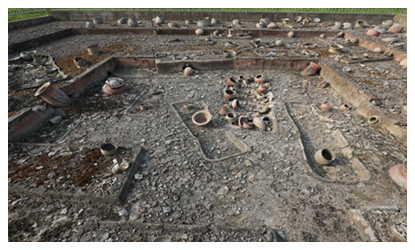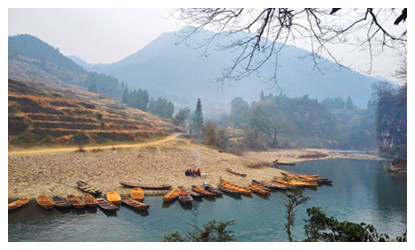Skype: neodalle-travel
Tel: +86 135 7447 2266
E-mail: sales@zhangjiajieholiday.com

During Prehistoric Times
 The paddy discovered at the ruins of Yuchanyan Cave in south Hunan's Daoxian county, traced back to 15,000 years ago. It is known as the earliest paddy sample in the world, demonstrating a transition trend from wild paddy to artificial cultivation.
The paddy discovered at the ruins of Yuchanyan Cave in south Hunan's Daoxian county, traced back to 15,000 years ago. It is known as the earliest paddy sample in the world, demonstrating a transition trend from wild paddy to artificial cultivation.
According to archeological excavations from Pengtoushan Site in Lixian county, Hunan has entered the Neolithic Age since 9,000 years ago.
According to archeological excavations from Mengxi Sanyuan Palace site in Lixian county and Huachenggang site in Anxiang county, Hunan reached the boom period of matriarchal clan society 6,500 years ago.
According to archeological excavations from Huachenggang site in Anxiang county and Chegu Mountain site in Huarong county, Hunan entered patriarchal society 5,000 years ago. 2,200 B.C, Hunan entered the late Neolithic Age, with primitive cultivation culture relics spreading over the province
During the Shang Dynasty
Ancient residents in Hunan area belong to ancient Miao and Yue clans. About 1,500 years ago, with the disintegration of primitive societies in most areas, Hunan gradually envovled into class society. After the middle period of the Shang Dynasty (1600 BC-1046 BC), Hunan entered the Bronze Age.
During the Zhou Dynasty
During the Spring and Autumn (770 BC-476 BC) and Warring States (770 BC-221 BC) periods, Hunan was brought into Chu kingdom's territory. With expansive production of brozen, Hunan entered the Iron Age.
In late Warring State period, Hunan became a stronghold of Chu kingdom, with its economy and culture gaining rapid growth. Changsha and its sourrounding areas developed into a main grain production base of the kingdom.
During the Qing Dynasty
Changsha Jun (prefecture) and Qianzhong Jun (prefecture) were established during Qin Dynasty, and Lingqu Canal was dug to connect Xiangjiang River and Lijiang River in today's Guangxi province.
During the Han Dynasty
In the Western Han Dynasty (206 B.C.- 24 A.D.), a paralle system (allowing the coexistence of kingdom and Jun) was implemented in Hunan, with three Jun namely Guiyang, wuling and Lingling and Changsha kingdom established. Changsha Kingdom was the first feudal vassal state and the king was Wu Rui. In the Eastern Han Dynasty (25-220 A.D.), Changsha Kingdom was changed into Changsha Jun.
During the Three Kingdom Peried
Going through the Three Kingdoms, Jin, and the Northern and Southern Dynasty (220 A.D.-581 A.D.), Hunan became a famous grain production area for its political stability and growing economy.
During the Tang Dynasty
During the Tang Dynasty (618 A.D.-907 A.D.), Hunan occupied parts of the western Jiangnan Dao, the eastern Shannan Dao and Qianzhong Dao. The government office for "Hunan militia officer" was set then, which was the earliest mention of "Hunan" in China's history.
In the Five Dynasties and Ten Kingdoms Period (907 A.D.- 979 A.D.)
Ma Yin established the Post-Chu regime. Hunan became one of the ten separated feudal kingdoms that time.
During the Song Dynasty (960 A.D.-1297 A.D.)
In the Song Dynasty, Hunan belonged to the Hubei Lu and Hunan Lu of Jinzhou.
During the Yuan Dynasty
Yuan Dynasty (1279 A.D.-1368 A.D.) implemented the provincial system. Except that Yongshun local government belonging to Sichuan province, all the rest of Hunan became under the jurisdiction of Huguang province. Tusi system was implemented in Xiangxi minority settlements.
During the Ming Dynasty (1368–1644)
 Hunan belong to Huguang provincial administrative government. The Tusi system was further completed.
Hunan belong to Huguang provincial administrative government. The Tusi system was further completed.
During the Qing Dynasty (1644-1912)
In the third year of the reign of Emperor Kangxi in the Qing Dynasty (1664), left Huguang provincial admistrative government office was set up in Changsha, hence the Hunan province was officially established.
In 1852, Zeng Guofan built Xiang Army in Hunan to suppress the Taiping Rebellion.
In 1989, Hunan became the only province to back the Hundred Days' Reform.
In 1899 and 1904, Yueyang and Changsha were successively opened up as commercial ports under the oppression of imperialism.
In 1903, Huang Xing established the Huaxinghui (China Revival Society) and became one of the key figures of the Tongmenghui (Chinese Revolutionary Alliance).
During the Republic of China(1912-1949)
Hunan province is one of provinces in China. Changsha is the capital of Hunan Province.
Top Events in Hunan
In 1903, Huang Xing established the Huaxinghui (China Revival Society) and became one of the key figures of the Tongmenghui (Chinese Revolutionary Alliance).
In April 1918, Mao Zedong and Cai Heseng established Xinmin Institute in Changsha.
In the winter of 1920, the Changsha Socialist Youth League and Changsha Communist Group were set up.
In July 1921, Mao Zedong and He Shuheng attended the First National Congress of Chinese Communist Party. In that October, Hunan Party branch was established and in the ensuing May, the executive committee of CPC Hunan area came into existence.
During the Northern Expedition from 1926 to 1927, Hunan's peasant movement was flourishing, with the participating peasants topped to 6 million.
In September 1927, Mao Zedong led the Autumn Harvest Uprising in Hunan-Jiangxi border and founded the first national rural revolutionary base areas in the Jinggang Mountain.
On November 13th 1938, "Wenxi Fire" destroyed Changsha.
From 1939 to 1942, Japanese army invaded Changsha three times. In 1943, Changde was attacked and in 1945, Xuefeng Mountain battle broke out.
On August 15th, 1945, Japan surrendered unconditionally in Zhijiang, Hunan province.
On August 4th, 1949, the Kuomingtang (KMT) General Cheng Qian and Chen Mingren led the uprising and achieved peaceful liberation for Hunan.
During the People's Republic of China(1949-- )
In 1978, four universities, Xiangtan University, Hunan University, Central South Institute of Mining and Metallurgy (now the Central South University) and the Changsha Institute of Technology (now the National University of Defence Technology) were approved as national key universities by the State Council.
In 1979, remedial work was undertaken to develop truth criterion discussions and to redress any unjust, false and wrong cases.
In 1981, chaired by Yuan Longping, one of the most distinguished agricultural experts in Hunan, the 'Super Hybrid Rice' (long shaped) research prize was awarded to Yuan Longping and his team as the first special prize for national scientific and technological inventions since the founding of The People's Republic of China.
In the early 1980s, the household contract responsibility system was implemented and improved throughout the countryside of Hunan Province.
In 1984, the all-round technological system reform was implemented to promote the successful pilot reform experience of the Zhuzhou Electronics Institute.
In 1984, the separation of Government and Community (setting social organization apart from government) and the establishment of Township Government marked the end of the people's commune system.
In 1985, in-depth price reform was implemented throughout the Province, ending the 32-year-old apportioned purchasing system of agricultural by-products.
The Dongting Lake was expanded by one-quarter of its size after the implementation of the Dongting Lake project begun in 1986. (In total the work will be achieved in two phases, one commenced in 1986 and the second one in 1997)
 Ask Questions ?
Ask Questions ?